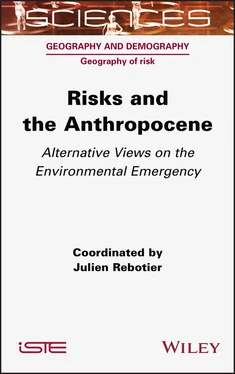I.2.3. … to the strengthening of meta-narratives
As a result of the disciplinary divisions, the truth of geology is not the same as that of the social sciences. Framing effects are at work here. Under cover of the authority of the discourses produced by legitimate sciences, we can convey ways of seeing the world. It is the role of the social sciences to identify the meanings produced, to identify the sources of the arguments on which they are based, as well as the interests, the expectations or the benefits linked to social positions. Numerous works contribute to exploring the social scope of the controversies surrounding the Anthropocene (Lorimer 2017), to making explicit the images of the world conveyed (Bonneuil 2015), and even to considering the agenda of autonomous research on the subject (Lövbrand et al . 2015; Davis and Todd 2017).
In this respect, the identification of major narratives conveyed by the Anthropocene is instructive of the possible contributions of social sciences (Bonneuil 2015):
– Earth sciences introduce a naturalistic narrative, which separates man and nature, by giving science and technology the means to sound the alarm and to find solutions. The advent of a global and homogeneous environmental conscience justifies that problems and solutions draw from the same source (Crutzen and Stroemer 2000);
– the postnature narrative does not recognize the modern separation between nature and culture. It comes into play to the extent that it recognizes that the outcome of actions is beyond the control of the will alone. We humans “become geology” (Latour 2015) and the emerging reflexive subject must acknowledge this (Beck 1992). The great divide between nature and culture blurs to define a common hybrid, of humans and non-humans, able to identify the environmental question as superior and ultimate;
– the ecocatastrophic narrative has been a recent bestseller (Servigne and Stevens 2015), while at the same time reviving the apocalyptic reflections of the post-Second World War era (Anders 1995) or those dealing with the autonomy of technology (Mumford 1950). From the limits of the planet to the prospect of collapse, it is impossible for societies to think of themselves as being alone in the maneuver. The capacity for action is shifted toward a kind of ecomodernism that would allow us to act in a more relational way on/with the environment (of which societies are part);
– the ecomarxist narrative applies the grid of reading historical materialist antagonisms (Keucheyan 2014; Moore 2017a), opposing classes and interests. The Anthropocene moment is the contemporary theater of the contradictions of capitalism, especially those that confront it with the depletion of resources in a finite world. The environmental crisis is the manifestation of an asymmetrical globalization of the economic world, reactivating the themes of inequality, exploitation and domination;
– the feminist political ecology narrative links the mechanisms of economic exploitation that transpire during the Anthropocene to other strands of domination. Issues of gender, community, racialization, sexual orientation, or faith, from an intersectional perspective (Gandy 2015; Yusoff 2018), weave the differentiated fabric of environmental crisis.
The work of contextualizing and explicating the grand narratives that accompany possible Anthropocenes also concerns the discourses held by the social sciences themselves (Lövbrand et al. 2015). Social science knowledge is always produced in the plural, under social conditions that need to be identified, both within the scientific field and in the social world (Bourdieu 2001).
I.2.4. Thinking about Anthropocenes from the social sciences
During the last decade, the growing production of work by the social sciences on the Anthropocene has been “foundational”. Collective articles seek to “reconceptualize” the Anthropocene – so as not to leave it to the Earth sciences? To defend competing interpretations of the social world? (Palsson et al. 2013; Lövbrand et al. 2015; Brondizio et al. 2016). Some elements of reflection are recurrent. This is the case of Anthropocene thought as an opportunity to break with the modern division between nature and culture. But very distinct positions clearly identify very different currents, sometimes in obvious opposition:
– the stream most compatible with the framing of the Anthropocene by the Earth sciences claims a joint research agenda (Brondizio et al. 2016). We find co-publishing authors who share a form of universalization of processes (Steffen et al. 2007) and agree on the identification of thresholds (tipping points), the place of numbers in a generalized equivalence and the evaluation of limit values with a global scope (planet boundaries), or an approach based on scenarios. However, the potential coupling of “social sciences and physical sciences” (Castree et al. 2014) is only a fraction of what the social sciences can contribute. Integration is not questioned when it suggests that the sum of knowledge necessarily leads to better knowledge... which is not self-evident, however;
– another current claims a more interpretative perspective that explores the possible meanings of the Anthropocene for the social world through a new form of weaving on (and with) the Earth (Tsing 2017). Humans are becoming aware of a common, interdependent humanity through the multiple, complex, random and not entirely predictable interactions with living things and the rest of the geochemical dynamics. The Gaia hypothesis is taken up by Lovelock and Margulis (1974) through the Anthropocene and this new era that forces Earthlings to cohabit with others, human and non-human, “under the authority of a power without political institution yet assured” (Latour 2017, p. 115). The reflexive human subject is no longer the pivot of an anthropocentric existence. It is the “assemblages of organic species and a biotic actors that make history” (Haraway 2016, p. 76) and create new familiarities, extended kinships, toward another form of shared world (as exemplified by the COVID-19 pandemic in 2020). Proponents of this current assess the complex “web of life”, which is “unruly, rebellious, and has a way of continually upsetting the best laid plans of states, of capitalists, of scientists and engineers” (Moore 2017c, p. 177);
– a third current breaks more clearly with the Earth sciences (Lövbrand et al. 2015) as with the proponents of a “posthuman” thought (which moves from the human condition to that of Earthlings, human and non-human). Vectoring a form of pagan spirituality, the fable of the “We-common-earthling” (or humanity) is not convincing (Hornborg 2017). For this latter, yet very composite, current, blindly universalizing thought disarms the critique of capitalism, the springs of injustice and forms of domination (Malm and Hornborg 2014). In order to shed light on the matrix genesis of the Anthropocene, authors have introduced new terms such as “capitalocene” (Moore 2017a, 2018), pointing to globalized capitalist exploitation, or “plantacionocene” (Ferdinand 2019), denouncing the colonial fact. In both cases, the idea is not to reduce the Anthropocene to a material consequence of capitalism or colonialism but to extend it to a relationship to the world, to ways of relating to all elements of the “web of life,” to an imaginary penetrated by multifaceted and invasive fronts of appropriation that place all things in equivalence (Moore 2003). The perspective of a “world-ecology” reveals the divergence of elements and their complex, reciprocal relationships that connect – and make – the world without obliterating the inequalities, asymmetries, contradictions and antagonisms of a more materialist analysis (Peet and Watts 1996; Castree et al. 2014; Davis and Todd 2017).
Читать дальше












